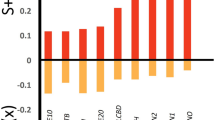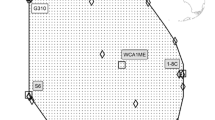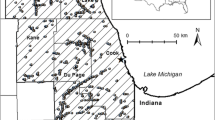Abstract
Using multivariate analysis, we created a hierarchical modeling process that describes how differently-scaled environmental factors interact to affect wetland-scale plant community organization in a system of small, isolated wetlands on Mount Desert Island, Maine. We followed the procedure: 1) delineate wetland groups using cluster analysis, 2) identify differently scaled environmental gradients using non-metric multidimensional scaling, 3) order gradient hierarchical levels according to spatiotemporal scale of fluctuation, and 4) assemble hierarchical model using group relationships with ordination axes and post-hoc tests of environmental differences. Using this process, we determined 1) large wetland size and poor surface water chemistry led to the development of shrub fen wetland vegetation, 2) Sphagnum and water chemistry differences affected fen vs. marsh / sedge meadows status within small wetlands, and 3) small-scale hydrologic differences explained transitions between forested vs. non-forested and marsh vs. sedge meadow vegetation. This hierarchical modeling process can help explain how upper level contextual processes constrain biotic community response to lower-level environmental changes. It creates models with more nuanced spatiotemporal complexity than classification and regression tree procedures. Using this process, wetland scientists will be able to generate more generalizable theories of plant community organization, and useful management models.





Similar content being viewed by others
References
Allen TFH, Starr TB (1982) Hierarchy: perspectives for ecological complexity. University of Chicago, Chicago
Allen TFH, Hoekstra TW (1991) Role of heterogeneity in scaling of ecological systems under analysis. In: Kolasa J, Pickett STA (eds) Ecological heterogeneity. Springer-Verlag, New York, pp 47–68
Bowker MA, Belnap J, Davidson DW, Goldstein H (2006) Correlates of biological soil crust abundance across a continuum of spatial scales: support for a hierarchical conceptual model. Journal of Applied Ecology 43:152–163
Brinson MM (1993) A hydrogeomorphic classification for wetlands. WRP-DE-4. U.S. Army Corps of Engineers Waterways Experiment Station, Vicksburg
Carpenter SR, Turner MG (2000) Hares and tortoises: interactions of fast and slow variables in ecosystems. Ecosystems 3:495–497
Colwell RK (2005) EstimateS: statistical estimation of species richness and shared species samples. Available via http://purl.oclc.org/estimates.
Crow GE, Hellquist CB (2000) Aquatic and wetland plants of Northeastern North America, Vols. 1 and 2. The University of Wisconsin, Madison
Curtis JT (1959) The vegetation of Wisconsin: an ordination of plant communities. The University of Wisconsin, Madison
Damman AWH (1977) Geographical changes in the vegetation pattern of raised bogs in the Bay of Fundy Region of Maine and New Brunswick. Vegetatio 35:137–151
Damman AWH, French TW (1987) The ecology of peat bogs of the glaciated Northeastern United States. Biological Report 85(7.16). U.S. Fish and Wildlife Service, Washington
Dufrêne MP, Legendre P (1997) Species assemblages and indicator species: the need for a flexible asymmetrical approach. Ecological Monographs 67:345–366
Girardin MP, Tardif J, Bergeron Y (2001) Gradient analysis of Larix laricina dominated wetlands in Canada's southeastern boreal forest. Canadian Journal of Botany 79:444–456
Glaser PH, Janssens JA, Siegel DI (1990) The response of vegetation to chemical and hydrological gradients in the Lost River Peatland, Northern Minnesota. Journal of Ecology 78:1021–1048
Gleason HA, Cronquist A (1991) Manual of vascular plants of northeastern United States and adjacent Canada, 2nd edn. The New York Botanical Garden, Bronx
Kahl S, Manski D, Flora M, Houtman N (2000) Water resources management plan. Acadia National Park, United States Department of Interior, National Park Service, Bar Harbor
Keddy PA (1983) Shoreline vegetation in Axe Lake, Ontario: effects of exposure on zonation patterns. Ecology 64:331–344
Kenkel NC (1987) Trends and interrelationships in boreal wetland vegetation. Canadian Journal of Botany 65:12–22
Kratz TK, DeWitt CB (1986) Internal factors controlling peatland-lake ecosystem development. Ecology 67:100–107
Lachance D, Lavoie C (2004) Vegetation of Sphagnum bogs in highly disturbed landscapes: relative influence of abiotic and anthropogenic factors. Applied Vegetation Science 7:183–192
Lenssen JPM, Menting FBJ, Van der Putten WH (2003) Plant responses to simultaneous stress of waterlogging and shade: amplified or hierarchical effects? New Phytologist 157:281–290
Levin SA (1992) The problem of pattern and scale in ecology. Ecology 73:1943–1967
Little AM (2005) The effects of beaver inhabitation and anthropogenic activity on freshwater wetland plant community dynamics on Mount Desert Island, Maine, USA. Dissertation, University of Wisconsin-Madison
McCune B, Grace JB (2002) Analysis of ecological communities. MjM Software Design, Gleneden Beach
McCune B, Mefford MJ (1999) PC-ORD for Windows, multivariate analysis of ecological data. Version 4.25. MjM Software, Gleneden Beach
Mitsch WJ, Gosselink JG (2000) Wetlands, 3rd edn. Wiley, New York
Moore PD, Bellamy DJ (1974) Peatlands. Elek Science, London
Nicholson BJ (1995) The wetlands of Elk Island National Park: vegetation classification, water chemistry, and hydrotopographic relationships. Wetlands 15:119–133
Nielsen MG (2006) Hydrogeomorphic classification of wetlands on Mt. Desert Island, Maine, including hydrologic susceptibility factors for wetlands in Acadia National Park, Report 2006-5162. U.S. Geological Survey, Reston
Nielsen MG, Guntenspergen GR, Neckles HA (2006) Using hydrogeomorphic criteria to classify wetlands on Mt. Desert Island, Maine — approach, classification system, and examples, Report 2005–5244. U.S. Geological Survey, Reston
O'Neill RV, DeAngelis D, Waide JB, Allen TFH (1986) A hierarchical concept of ecosystems. Princeton University, Princeton
Ogden JC, Davis SM, Jacobs KJ, Barnes T, Fling HE (2005) The use of conceptual ecological models to guide ecosystem restoration in South Florida. Wetlands 25:795–809
Paine RT, Levin SA (1981) Intertidal landscapes: disturbance and the dynamics of pattern. Ecological Monographs 51:145–178
Peters DPC, Bestelmeyer BT, Turner MG (2007) Cross-scale interactions and changing pattern-process relationships: consequences for system dynamics. Ecosystems 10:790–796
van Breemen N (1995) How Sphagnum bogs down other plants. Trends in Ecology & Evolution 10:270–275
Vitt DH, Bayley S (1984) The vegetation and water chemistry of four oligotrophic basin mires in northwestern Ontario. Canadian Journal of Botany 62:1485–1500
Young DR, Porter JH, Bachmann CM, Shao G, Fusina RA, Bowles JH, Korwan D, Donato TF (2007) Cross-scale patterns in shrub thicket dynamics in the Virginia barrier complex. Ecosystems 10:854–864
Zoltai SC, Vitt DH (1995) Canadian wetlands: environmental gradients and classification. Vegetatio 118:131–137
Acknowledgments
This research was funded by the US Geological Survey’s Natural Resources Preservation Program grant to GG and Hilary Neckles. We thank the US Geological Survey SCEP program, the University of Wisconsin-Madison Department of Botany, and the Society of Wetland Scientists for support to AL. David Manski, Bill Gawley, Bruce Connery, Karen Anderson, and Brook Childrey at Acadia National Park provided logistical, laboratory, GIS, and archival support. Christie Peschka, Megan Gahl, Liz Willey, Anna Kettel, Matt Kuchta, and Adam Flaaten helped collect field data. John Pastor, Charles Canham, and several anonymous reviewers made very helpful comments on earlier versions of this manuscript.
Author information
Authors and Affiliations
Corresponding author
Electronic supplementary material
Below is the link to the electronic supplementary material.
Supplement 1
Doc (219 KB)
Supplement 2
Doc (154 KB)
Rights and permissions
About this article
Cite this article
Little, A.M., Guntenspergen, G.R. & Allen, T.F.H. Conceptual Hierarchical Modeling to Describe Wetland Plant Community Organization. Wetlands 30, 55–65 (2010). https://doi.org/10.1007/s13157-009-0010-5
Received:
Accepted:
Published:
Issue Date:
DOI: https://doi.org/10.1007/s13157-009-0010-5




